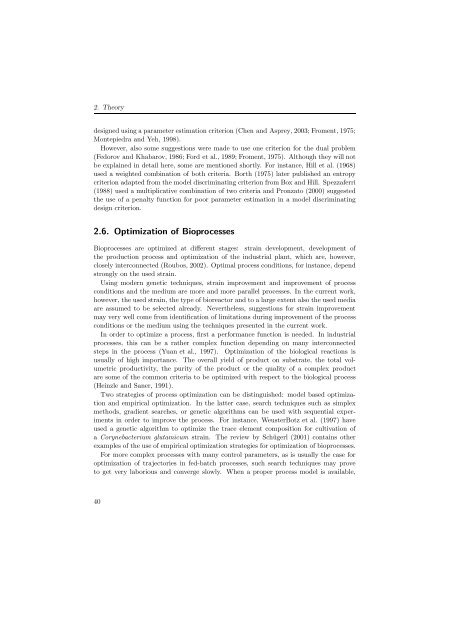Corynebacterium glutamicum - JUWEL - Forschungszentrum Jülich
Corynebacterium glutamicum - JUWEL - Forschungszentrum Jülich
Corynebacterium glutamicum - JUWEL - Forschungszentrum Jülich
Create successful ePaper yourself
Turn your PDF publications into a flip-book with our unique Google optimized e-Paper software.
2. Theory<br />
designed using a parameter estimation criterion (Chen and Asprey, 2003; Froment, 1975;<br />
Montepiedra and Yeh, 1998).<br />
However, also some suggestions were made to use one criterion for the dual problem<br />
(Fedorov and Khabarov, 1986; Ford et al., 1989; Froment, 1975). Although they will not<br />
be explained in detail here, some are mentioned shortly. For instance, Hill et al. (1968)<br />
used a weighted combination of both criteria. Borth (1975) later published an entropy<br />
criterion adapted from the model discriminating criterion from Box and Hill. Spezzaferri<br />
(1988) used a multiplicative combination of two criteria and Pronzato (2000) suggested<br />
the use of a penalty function for poor parameter estimation in a model discriminating<br />
design criterion.<br />
2.6. Optimization of Bioprocesses<br />
Bioprocesses are optimized at different stages: strain development, development of<br />
the production process and optimization of the industrial plant, which are, however,<br />
closely interconnected (Roubos, 2002). Optimal process conditions, for instance, depend<br />
strongly on the used strain.<br />
Using modern genetic techniques, strain improvement and improvement of process<br />
conditions and the medium are more and more parallel processes. In the current work,<br />
however, the used strain, the type of bioreactor and to a large extent also the used media<br />
are assumed to be selected already. Nevertheless, suggestions for strain improvement<br />
may very well come from identification of limitations during improvement of the process<br />
conditions or the medium using the techniques presented in the current work.<br />
In order to optimize a process, first a performance function is needed. In industrial<br />
processes, this can be a rather complex function depending on many interconnected<br />
steps in the process (Yuan et al., 1997). Optimization of the biological reactions is<br />
usually of high importance. The overall yield of product on substrate, the total volumetric<br />
productivity, the purity of the product or the quality of a complex product<br />
are some of the common criteria to be optimized with respect to the biological process<br />
(Heinzle and Saner, 1991).<br />
Two strategies of process optimization can be distinguished: model based optimization<br />
and empirical optimization. In the latter case, search techniques such as simplex<br />
methods, gradient searches, or genetic algorithms can be used with sequential experiments<br />
in order to improve the process. For instance, WeusterBotz et al. (1997) have<br />
used a genetic algorithm to optimize the trace element composition for cultivation of<br />
a <strong>Corynebacterium</strong> <strong>glutamicum</strong> strain. The review by Schügerl (2001) contains other<br />
examples of the use of empirical optimization strategies for optimization of bioprocesses.<br />
For more complex processes with many control parameters, as is usually the case for<br />
optimization of trajectories in fed-batch processes, such search techniques may prove<br />
to get very laborious and converge slowly. When a proper process model is available,<br />
40

















